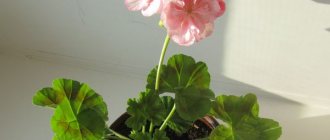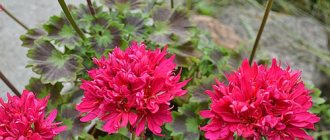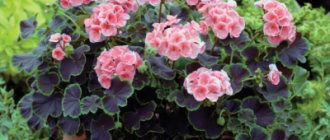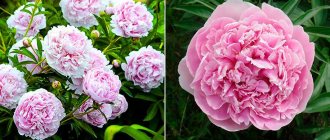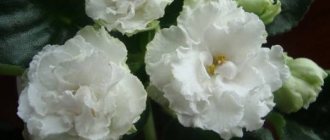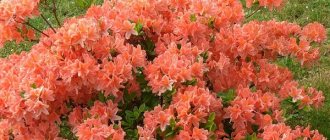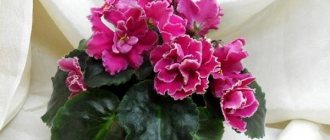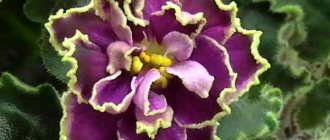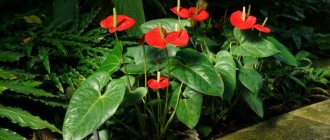Author of the article: Olga Viktorovna | Updated: 02/19/2022
XXI CENTURY Candy Fudge Scented water
266 ₽ More details
Video baby monitor Motorola MBP36S (white)
12900 ₽ More details
Children's onesies
Pelargonium is no longer that grandmother’s plant with inflorescences resembling umbrellas. This category is so diverse that it requires much more serious consideration. For example, this group also includes star pelargonium - a plant that certainly does not resemble the classic geranium known to many.
Overview of varieties
Star pelargonium is a fairly large category that includes a large number of varieties. Before making your choice, you should study their main characteristics in more detail. Only in this case will you select truly worthy specimens that will harmoniously complement your flower collection.
Among the popular varieties, it is worth highlighting Golden, Green, Joann, Jean cows, Lawrence, Lisa Jo, Pink, Polestar, Rhapsody, Rushmoor golden ruffles, Sagitarius, Sutarves bosna, Joanna, Diana, Caroline, Hudson, etc.
Lotta Lundberg
Such pelargonium with bright pink petals will certainly not leave anyone indifferent. Its buds resemble sharp miniature stars. The peduncle of this specimen is quite strong, but has a shade more prone to brown. As for the leaf plate, it is covered in places with dark stains.
This star-shaped shrub is compact, making it a great addition to any home collection. But if you eventually want to arrange a flowerbed or some kind of alpine hill in your garden, be sure to give preference to this variety.
Bob Newing
This flower specimen primarily stands out among the entire variety of varieties for its bright pink-red petals. The buds form lush inflorescences, which are also openwork. The main characteristics of this variety also include a high peduncle. The leaves of this geranium are tricolor.
Bronze Butterfly
This variety of star pelargonium is valued by domestic flower growers not only for its beautiful and bright inflorescences. The foliage of the plant deserves special attention. It has a rich green color, and in the center there is a darker pattern, reminiscent of a butterfly, which turns bronze in the sun. The star-shaped inflorescences of this specimen are quite large and peach-colored. They are also terry, so they look very voluminous.
Rushmoor Bondi Blue
This flower specimen is worth paying attention to not only because its buds are very beautiful. The leaf plate of such a plant also looks aesthetically pleasing. It has a peculiar pattern in the center that complements the miniature composition. The inflorescences of the Rushmoor Bondi Blue variety are double, their shape is somewhat curved, but looks elegant. Those who want to add a specimen with delicate purple petals to their flower collection should pay attention to this variety of homemade geranium.
Little Linda
What is primarily notable about this variety is its golden foliage. Its petals are double and light pink in color. Moreover, the buds consist of narrow, elongated petals, which look quite aesthetically pleasing. It’s worth purchasing such a flower specimen, if only because it blooms very often, so it will delight you with bright inflorescences almost all year round.
Bev Foster Stellar
The Foster Stellar variety of geranium is a miniature specimen. The leaf blade of such a flower is green, but its zonal ring is usually darkened. You should definitely include this plant in your collection, because it has very beautiful, bright, double buds. Moreover, the color of the petals in this case is multifaceted, therefore it includes pink, crimson, orange, and red shades.
This compact variety of homemade geranium will appeal to many. It does not develop very intensively, but does not require special care. In addition, you will certainly be satisfied with the bright and abundant flowering.
Description of the species
The foliage of this plant is very beautiful. The color varies (depending on the specific variety). Most of these plants have deep green leaves with darkened areas. Some varieties have foliage that shimmers golden in the sun.
Flowers can be double or regular (depending on the specific variety of pelargonium). Inflorescences are dense or loose. The latter look fascinating. From a distance, such flowers look like a small flock of very beautiful unusual butterflies.
Pelargonium: secrets of growing at home
I am glad to welcome you, my dear friends, to the pages of my blog! I didn’t think for a long time about what to tell you about today, because just a few days ago I started propagating one of my favorite indoor plants.
Do you think this is an exotic unusual bush? You are mistaken, for a long time now I have had my grandmother’s inheritance on my windowsill - pelargonium, caring for it at home is quite simple, but has many tricks.
Do you also adore these beautiful lush plants with generous bright blooms? Then we will certainly find something to talk about on the blog pages!
Preparatory steps
First you should start preparing the seeds, which can be divided into several steps:
- Selection of seed material. Try to select high-quality seeds with an elongated shape. They should be brown without any damage.
- The next step is scarification, which will speed up the germination process. To remove the top layer you need to use any sharp object. This must be done carefully, taking care not to harm the seeds.
- Soil preparation. You can buy it at the store or make it yourself. Take 2 parts of turf soil and one part each of peat and sand. Stir the resulting mixture and place in the oven.
- Disinfection. It is carried out using a weak solution of potassium permanganate or peroxide.
- Soaking seeds. After all the preparatory work has been carried out, the seeds are soaked in water so that they swell.
Plant propagation
Let's look at how pelargonium reproduces. The flower is propagated in several ways:
Flower growers have long been accustomed to propagating plants in various ways; buying annuals in stores every year is expensive and unwise, but plucking a cutting from the mother plant is not difficult or expensive.
Pelargonium propagation by cuttings
This method of propagating a plant allows you to preserve all its original signs of growth.
Cuttings are harvested during the active growth of the plant, namely April-October; such cuttings will begin to delight with their flowering after a few months.
Cuttings are prepared in advance, their length should be up to 8 cm, with several leaves, fresh, dried in air for several hours. To ensure that young cuttings take root, a root system regulator can be used.
With positive care, cut shoots quickly begin to grow, they do not need to be covered, the main thing is to maintain a temperature of 20-23 degrees, and also water regularly. To prevent the young shoot from being exposed to diseases, it must be watered with caution, avoiding water getting on the young shoots. With positive care, the cutting begins to grow after 3-4 weeks.
As soon as the cutting begins to actively grow, it is transplanted into a separate container with a pre-prepared mixture.
Planting in containers
It is convenient to plant seeds in wide containers, no more than 5 cm high. Ordinary containers with lids, which can be purchased at any supermarket, are suitable for this. Fill the container with soil, leaving 1-1.5 cm of free space at the top.
Make small indentations using a match or a regular stick at a distance of 4-5 cm. Place the seeds in these holes and carefully sprinkle with earth. After this, the crops are sprayed with warm water. To avoid temperature changes, it is necessary to control the humidity of the crops.
Therefore, do not forget to cover them with a lid or cling film, and poke holes in some places.
On toilet paper
Place damp toilet paper in a container, place seeds on it at a distance of 4-5 cm and cover with a lid. After small white sprouts appear, they can be transplanted into the ground.
In peat tablets
You will need to soak the tablets in water, preferably warm. Keep in mind that tablets increase in size by 6 times when soaked. When the peat is wet, make a hole with a match and plant the seeds.
Pelargonium care
Pelargonium is popular among flower lovers, as the culture is not picky in its care. If she is given proper care, she will delight you with her bright color for a long time. But it happens that the flower does not want to bloom, no matter what forces are applied to it. In this case, you should study some rules for care and cultivation.
Geranium has a pleasant, incredible aroma, so factories make oils based on the flower.
Growing pelargonium is not difficult; by following just a few rules, you will achieve colorful and lush flowering. In just one season, the plant can produce more than 15 inflorescences.
Pelargonium produces many inflorescences at once, they may bloom unevenly, then it is better to remove the fading inflorescences so that the plant does not waste energy on them and allows other inflorescences to bloom.
Experienced gardeners plant pelargonium in their garden plots, because with proper care it will delight others with its beauty until late autumn. This is its difference and feature, which makes the flower a favorite among ornamental crops.
Features of reproduction
Stellaras are most often propagated by cuttings . The shoot for this purpose should be semi-lignified. Green cuttings may not have time to take root and rot. Peculiarities:
- Shoots must have at least three internodes and six to seven leaves. It is recommended to pinch off the lowest leaves.
- After cutting, the cuttings must be kept in paper in the open air for drying, and then placed in water or soil for rooting.
- It is necessary to provide the rooting shoots with warmth and sufficient light: in such conditions the survival rate is much higher.
- After two to three weeks, the cutting already has a root system and is ready to be transplanted into a small pot to ensure early flowering.
- Each specimen of star pelargonium remains healthy and decorative for up to 5 years, so the plant must be renewed regularly.
Pelargonium stellar acquires all the fullness and beauty of flowering a year after cuttings.
After the first acquaintance with star pelargoniums, it is impossible to remain indifferent to them. These plants are distinguished by their unpretentiousness and are easy to grow at home. Prostate care and beauty of stellars for everyone who loves home decorative plants.
If you find an error, please select a piece of text and press Ctrl+Enter.
How to properly care?
Watering
Moisten the flower in summer often, regularly and abundantly.- Remove water that has accumulated in the pan in a timely manner and prevent it from stagnating. So consider a drainage layer in the pot.
- Water for irrigation should be soft, non-calcareous and cool.
There is absolutely no need to maintain high air humidity, and spraying and bathing in the shower can harm the plant.
Temperature
During growth and flowering, the plant feels comfortable at a temperature of + 20 – +25 °C . During dormancy (October-February), star pelargonium requires coolness.
The optimal temperature for winter maintenance is +12 °C - +15 °C. But it is unrealistic to ensure this condition in an apartment, so you can follow the following rule: the warmer it is in the place where the pelargonium is kept, the more light there should be.
Feeding
During active growth (spring-autumn), star pelargonium needs feeding. Apply them at least 2 times a month. Liquid fertilizers are suitable for feeding pelargonium . Apply the mixtures to slightly moistened soil.
Fertilizers contain components such as nitrogen, potassium and phosphorus. To obtain abundant greens, you must choose a composition with a high nitrogen content. And for abundant flowering - with potassium and phosphorus.
Transfer
The container should not be large, otherwise the flower will not bloom. Procedure for transplanting a flower :
Fill the container with expanded clay, make drainage holes and fill it with a mixture of sand, compost soil, peat and humus, taken in equal proportions.- Fill 1/2 of the pot with potting soil.
- Remove the plants from the old pot, clear the root system of the old soil and plant in a new one. Lightly compact and water.
What it is?
Pelargonium Stellar owes its appearance to the Australian hybridizer Ted Both, who in 1960 crossed several species of zonal pelargoniums and as a result received this beautiful plant.
The appearance of pelargonium in Eurasia occurred more than four centuries ago. Ships traveling from England and Holland to India stopped at the Cape of Good Hope and bought plants there for collectors from Europe. The Cape Province of South Africa is considered the birthplace of pelargoniums .
Botanical description
These are perennial plants - herbaceous or subshrubs, with straight, branched or creeping stems. The flowers of this type of pelargonium are full of variety of colors and are collected in umbrella inflorescences. The fruit is a capsule with sepals that opens from bottom to top.
Appearance and features
Stellars are rightfully considered the most beautiful flowers of the pelargonium family. The original shape of the leaves, reminiscent of maple, is represented by a wide range of colors: shades of green, golden, chocolate, red and their combinations.
The flowers of the plant are shaped like stars , and in combination with double leaves and petals, stellars look elegant, spectacularly bright and cannot go unnoticed.
Photo of the plant
Here you can see a photo of star pelargonium:
Common diseases and pests
If the basic rules of agricultural technology are not followed, star pelargonium can be affected by the following diseases and pests:
Black leg . This is a fungal disease that attacks the base of the stem. The main reason is excessive soil compaction, waterlogging or contamination. You need to get rid of the flower and the soil. To prevent disease, after purchasing land, sterilize it and try not to over-water it in the future when caring for it.- Pulling out the stems . This is the result of a lack of light. It is necessary to move the flower pot to a bright place or provide sufficient artificial lighting.
- Gray mold .
It forms on the leaves. The main reason is infection with the fungus Botrytis. Remove the infected parts of the plant, and treat the flower itself with a fungicide. Important! When fighting gray mold, you will have to reduce watering and ventilate the room often. - Swelling on the leaves and rotting of the roots . This is the result of overwatering. To normalize the condition of the flower, simply adjust the frequency and volume of moisture.
- Aphids and whiteflies . These pests most often attack star pelargonium. You can get rid of them with the help of drugs that contain permethrin.
There are many varieties of pelargonium. Our website contains materials about the following varieties of pelargonium: Bold, April Snow, Angel, Gustav, PACK Viva Rosita, Rose Zonartik, Richard Hudson, Australian Pink Rosebud, Millfield rose, PACK Salmon Comtesse.
